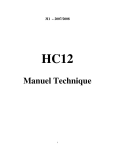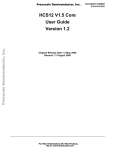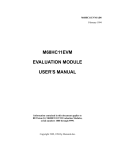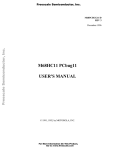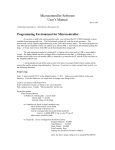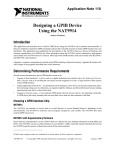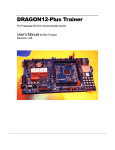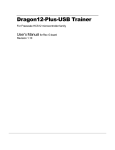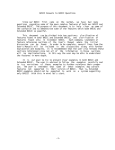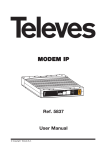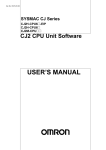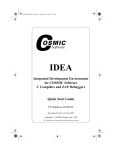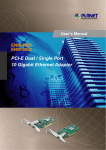Download Chapter 1 - Systems and Computer Engineering
Transcript
The 68HC12 Microcontroller Chapter 1 Introduction to 68HC12 Assembly Notation : Intel binary 10010011b decimal 1478 hexadecimal 5678h Motorola %10010011 1478 $5678 H. Huang Transparency No.1-1 The 68HC12 Microcontroller SYSC-2001 Review : Computer Hardware Organization Processor Control Unit Common Bus (address, data, & control) Datapath Arithmetic Logic Unit Registers Memory Program & Data Storage Output Units Input Units Figure 1.1 Computer Organization H. Huang Transparency No.1-2 The 68HC12 Microcontroller CPU: Microprocessor versus Microcontroller • Microprocessor: processor on a single integrated chip – Intel 80x86, Motorola 680x0 families... • Microprocessors evolved in two general directions: – Performance: processing power, data storage – Integration: amount of circuits on one chip • Microcomputer: computer using microprocessor as CPU – Combines microprocessor/peripheral chips -> computer system – i.e.: PC => Intel 80x86 + memory + timer + keyboard + modem (etc.) chips • Microcontroller: computer system on a chip – Microprocessor AND peripheral functions implemented on one chip – Built-in memory and interface circuits (I/O units) H. Huang Transparency No.1-3 The 68HC12 Microcontroller MicroComputer versus MicroController System Power Micro Processor CPU Power Memory Clock I/O Components Micro Processor CPU Clock Memory Extended Memory I/O Components Other I/O Peripheral H. Huang Transparency No.1-4 The 68HC12 Microcontroller Features of the 68HC12 Microcontroller - 16-bit CPU - 64 Kb memory space - 768 bytes to 4 Kb of EEPROM - 1 Kb to 12 Kb of on-chip SRAM - 32 Kb to 128 Kb flash memory - Sophisticated timer functions including: input capture, output compare, pulse accumulators, real-time interrupt, COP timer - Serial communication interfaces: SCI, SPI, CAN, BDLC - Background debug mode (BDM) - 8-bit or 10-bit A/D converter - Instructions for supporting fuzzy logic function H. Huang Transparency No.1-5 The 68HC12 Microcontroller Block Diagram of MC68HC12 PAD0 EEPROM Port AD A/D Converter RAM FLASH Timer & Pulse Accumulator PT0 Port T CPU12 SCI I/O SPI PWM PS0 Port S PP0 Port P I/O Port A* Port B* * Multiplex : Simple I/O or Extended Address/Data H. Huang Transparency No.1-6 The 68HC12 Microcontroller The 68HC12 Family • 68HC12 Family Members – Different memory and number/type of on-chip peripheral functions – Vary in fabrication methods (different power requirements, environmental tolerances, cost) Huang Text : CME-12BC32 Our lab : CML-9S12DP256 • Made from socket parts • One SCI channel • 1 A/D Converter • Made from surface-mount parts • Two SCI Channels • 2 A/D Converters Concepts : Use Text Specifics : Use Hardware Reference Manuals (posted on website) H. Huang Transparency No.1-7 The 68HC12 Microcontroller HC12 Programmer’s Model 7 15 A 07 D B 0 8-bit accumulator A and B 0 or 16-bit double accumulator D 15 X 0 Index register X 15 Y 0 Index register Y 15 SP 0 Stack pointer 15 PC 0 Program counter Figure 1.3 MC68HC12 CPU registers. H. Huang Transparency No.1-8 The 68HC12 Microcontroller Condition Code Register 7 6 5 4 3 2 1 0 S X H I N Z V C Figure 2.8 Condition code register C : Carry Flag Set if carry generated as a result of an operation V : Overflow Flag Sets if result of 2’s complement arithmetic operation is out of range Z : Zero Flag Set if result of an operation is zero N : Negative Flag Set if MSB of the result of an operation = 1 H : Half-carry Flag Set if carry from lower four bits to upper four bits as a result of an operation H. Huang Transparency No.1-9 The 68HC12 Microcontroller Instruction Set - 68HC12 instructions: one/two bytes -> opcode; zero-five bytes -> operand (addressing information). Opcode $18 Opcode Operands - Opcode: operation to be performed. First byte of two-byte opcode always $18. - Instruction (opcodes) classified into three groups 1. Data Transfer 2. Data Manipulation (Arithmetic and Logic) 3. Control Flow H. Huang Transparency No.1-10 The 68HC12 Microcontroller Source Code - Program written in assembly or high-level language Object Code - Output of an assembler or compiler - Executable program in binary format (machine instructions) line addr. 1: machine code (Assembly) source code = 00001000 org $1000 2: 1000 B6 0800 ldaa $800 3: 1003 BB 0801 adda $801 4: 1006 BB 0802 adda $802 6: 1009 7A 0900 staa $900 end H. Huang Transparency No.1-11 The 68HC12 Microcontroller Memory Format of the 68HC12 family • HC12: 16-bit processor. It can read 16-bit words organized as 8-bit bytes. – On Motorola’s, words accessed with Big Endian format Address Memory Address 1202 $1200 $1201 $1202 $1203 $1204 Data 5E 73 A2 95 0A Byte at Address 1202 = $A2 Word at Address 1202 = $A295 Big Endian %1010 0010 Data is 8 bits H. Huang Transparency No.1-12 The 68HC12 Microcontroller MC68HC12 Memory Map • Different members of the HC12 family: different amounts of on-chip SRAM, EEPROM and flash memory • Education boards: external SRAM and EEPROM to facilitate program downloading/debugging • HC12 can only access 64Kbytes of memory (16-bit processor). Larger memory spaces: special “bank-switching” techniques • Memory mapped to allocate different kinds of data and instructions (single-chip; expanded mode) • More information about memory mapping: board’s user manual. H. Huang Transparency No.1-13 The 68HC12 Microcontroller MC68HC12 Memory Map for DP256 Simulator Lab FFFF FF00 Vector Address FFFF EEPROM and Flash External EEPROM 8000 7FFF 16kbytes External RAM Code 4000 3FFF 8000 7FFF 16kbytes External RAM 4000 3FFF 12Kbytes Internal RAM 1FFF 1000 0FFF Data 4kbytes Internal EEPROM 1000 BFF 8 kbytes Internal EEPROM 1 Kbytes Internal RAM 800 400 3FF 3FF 200 Peripheral Area 1FF 0000 HC12 Internal Registers 200 Peripheral Area 1FF 0000 HC12 Internal Registers H. Huang Transparency No.1-16 The 68HC12 Microcontroller HC12 Simulator • Microcontroller simulator: tool (program) that replicates the operation of a microcontroller – Learn about/ develop code without having the hardware • HC12 simulator mimics operation of HC12 microcontroller – Displays and changes “registers” – Displays and changes “memory” – “Executes” code, changing contents of simulated memory/ registers according to the semantics of instructions executed H. Huang Transparency No.1-17 The 68HC12 Microcontroller HC12 Simulator We will use a freeware simulator available at http://www.electronikladen.de/hc12 This simulator is a Java program, so you will need to have a JDK on your machine www.sun.org Instructions for running the simulator are provided in a note on the course webpage. H. Huang Transparency No.1-18 The 68HC12 Microcontroller Simulator Demo H. Huang Transparency No.1-19 The 68HC12 Microcontroller I/O Ports and I/O Addresses Enable exchange of data between chip and external I/O devices - A port for a particular device identified by I/O Address Address Decoder CE Interface chip 1 CE Interface chip 1 Micro processor Data Bus Figure 7.1 Interface chip, I/O devices, and microprocessor H. Huang Transparency No.1-20 The 68HC12 Microcontroller I/O Addressing Schemes: Isolated I/O - Based on a separate address space for I/O devices. - Programming: use dedicated instructions for I/O operations. Control (RD/WR) Memory Map Processor FFFF Data I/O Map 0xFF Address Memory 0000 I/O Device 0000 I/O Control (IOR/IOW) H. Huang Transparency No.1-21 The 68HC12 Microcontroller I/O Addressing Scheme : Memory Mapped I/O • Both I/O and memory shared same memory space. • Programmer’s: same instructions for both memory and I/O Memory Map Control (RD/WR) Processor FFFF Data Address Memory I/O Device I/O Map 0000 H. Huang Transparency No.1-22 The 68HC12 Microcontroller Programming MicroControllers Using a High-level Language • Syntax: closer to human languages • Translator (Compiler): convert program in high-level language into machine language • Allow the users to work on the program logic at higher level. Machine Language (executable code) • Sequence of binary digits that can be executed by the processor Assembly Language (mnemonic code) • • Assembly instruction: representation of a machine instruction (1 assembly instruction = 1 machine instruction) Hard to understand, program, and debug for humans Real-Time Embedded Systems programming • • High level languages not adequate: performance issues Memory space (Java exe >> C exe >> Assembly exe = machine exe) H. Huang Transparency No.1-23 The 68HC12 Microcontroller 68HC12 Instruction Examples: Load and Store - LOAD: copies contents of operand into CPU register. - STORE: save contents of CPU register into memory location. - Execution affects certain flags - N and Z flags of the CCR automatically updated; V flag cleared. Learning HC12 Instructions : (1) Built-in Operands Mnemonic STAA STAB STD STS STX STY Function Store A Store B Store D Store SP Store X Store Y Operation (A) ⇒M (B) ⇒M (A) ⇒M, (B) ⇒ M+1 (SP) ⇒M, M+1 (X) ⇒M:M+1 (Y) ⇒M:M+1 H. Huang Transparency No.1-24 The 68HC12 Microcontroller Learning New HC12 Instructions (1) : Built-in Operands Mnemonic LDAA LDAB LDD LDS LDX LDY LEAS LEAX LEAY Function Operation Load A (M) ⇒ A Load B (M) ⇒B Load D (M:M+1) ⇒(A:B) Load SP (M:M+1) ⇒SP Load index register X (M:M+1) ⇒ X Load index register Y (M:M+1) ⇒ X Load effective address into SP Effective address ⇒SP Load effective address into X Effective address ⇒X Load effective address into Y Effective address ⇒Y H. Huang Transparency No.1-25 The 68HC12 Microcontroller Flags = SXHINZVC Learning New HC12 Instructions (2) : Addressing Modes Source Operation Mode Coding Flags LDAA #opr8i (M)=>A IMM 86 ii ----xx0- LDAA opr8a Load Accumulator A DIR 96 ii LDAA opr16a EXT B6 hh ll LDAA oprx0_xysp IDX A6 xb LDAA oprx9, xysp IDX1 A6 xb ff LDAA oprx16,xysp IDX2 A6 xb ee ff LDAA [D, xysp] [D,IDX] A6 xb LDAA [oprx16,xysp] [IDX2] A6 xb ee ff H. Huang Transparency No.1-26 The 68HC12 Microcontroller Addressing Modes Inherent Addressing Mode - Instructions do not use extra bytes for operands: instructions either do not need operands or all operands are CPU registers. - Operands are implied by the opcode. - Examples: NOP INX DECA H. Huang Transparency No.1-27 The 68HC12 Microcontroller Immediate Addressing Mode - Operands included in the instruction. - CPU does not access memory for operands. - Examples: LDAA #$55 LDX #$800 Operand Compatibility : - What if we now have LDX #$55 ? Instruction encoding : • LDAA #$55 • LDX #$55 86 55 CE 00 55 - What’s wrong with this ? LDAA #$1234 H. Huang Transparency No.1-28 The 68HC12 Microcontroller Direct Addressing Mode - Can only specify memory locations in the range of 0– 255. - Uses only one byte to specify the operand address. - Examples: LDAA $20 LDAB $40 Extended Addressing Mode - Full 16-bit address provided in the instruction. - Examples: LDAA $4000 LDX $FE60 H. Huang Transparency No.1-29 The 68HC12 Microcontroller Indexed Addressing Mode(s) • Operand tells how to calculate effective address of the data • Many forms calculate address as sum of parts • Parts = registers and/or constants. • Effective address = Sum of index register (X, Y, PC, or SP) and offset to specify address of an operand. • Offset can be 5-bit, 9-bit, and 16-bit signed value or value in accumulator A, B, or D Hence, the many different forms … H. Huang Transparency No.1-30 The 68HC12 Microcontroller The Various Forms of Indexed Addressing 1. 5-bit Constant Offset (Indexed Addressing) Examples : ldaa 2. 0,X stab -8,X The range of the offset : -16 to +15. 9-bit Constant Offset Examples : ldaa $FF,X ldab -20,Y The range of the offset : -256 to +255 3. 16-bit Constant Offset Examples: ldaa 2000,X staa 4000,Y Allows access any location in the 64-KB range 4. Accumulator Offset Examples: ldaa B,X stab B,Y The offset is contained in either A, B or the 16-bit accumulator D. H. Huang Transparency No.1-31 The 68HC12 Microcontroller 16-bit Constant Indirect Indexed Addressing Mode - 16-bit offset added to index register to form address of memory location containing a pointer to memory location affected by the instruction. - Square brackets distinguish this addressing mode from 16-bit constant offset indexing. For example, LDAA [10,X] STAA [20,Y] Compare : LDAA 10, X LDAA [10,X] H. Huang Transparency No.1-32 The 68HC12 Microcontroller 16-bit Constant Indirect Indexed Addressing (example) 1000 … 100A 10 100B 22 … 1020 2f 1021 10 1022 ff LDAA 10, X ; Suppose X=1000 ; A <- m(000A+1000) = 10 LDAA [10, X] ; A <- m[m(000A+1000)] = m(1022) = ff H. Huang Transparency No.1-33 The 68HC12 Microcontroller Transfer and Exchange Instructions - Copy the contents of a CPU register or accumulator into another CPU register or accumulator. 1. Universal Transfer Instruction: TFR abcdxys, abcdxys TFR • A, B Transfers contents of A to B TFR does not affect any flags. 2. Specific Transfer Instructions TAB Transfers contents of A to B TBA Transfer contents of B to A • Both affect the N, Z, and V condition code bits. H. Huang Transparency No.1-34 The 68HC12 Microcontroller Transfer and Exchange Instructions 3. Exchange contents of a pair of registers or accumulators. EXG A, B Swap contents of A and B 4. Sign-extend 8-bit two’s complement number into a 16- bit number SEX • A,X Move contents of A into LSB of X, and sign extend Purpose: To use an 8-bit value in 16-bit signed operations. H. Huang Transparency No.1-35 The 68HC12 Microcontroller Move Instructions - Move data bytes or words from a source to a destination in memory. - Six combinations of immediate, extended, and index addressing modes allowed to specify source/destination addresses: IMM ⇒ EXT, IMM ⇒ IDX, EXT ⇒ EXT, EXT ⇒ IDX, IDX ⇒ EXT, IDX ⇒ IDX - Examples: MOVB $100,$800 MOVW 0,X, 0,Y H. Huang Transparency No.1-36 The 68HC12 Microcontroller Flags = SXHINZVC Add and Subtract Instructions • Destinations of these instructions are always a CPU register or accumulator. Source Operation Mode Coding Flags ADDA #opr8i (A)+(M)=>A IMM 8B ii --x–xxxx ADDA opr8a Add w/o Carry to A DIR 9B ii ADDA opr16a EXT BB hh ll ADDA oprx0_xysp IDX AB xb ADDA oprx9, xysp IDX1 AB xb ff ADDA oprx16,xysp IDX2 AB xb ee ff ADDA [D, xysp] [D,IDX] AB xb ADDA [oprx16,xysp] [IDX2] AB xb ee ff H. Huang Transparency No.1-37 The 68HC12 Microcontroller Variations of the Same Theme Adding TO OTHER registers adda $800 ; A ⇐ [A] + [$800] addb $800 ; B ⇐ [B] + [$800] addd $800 ; D ⇐ [D] + [$800] WORD! Adding TWO registers aba ; A ⇐ [A] + [B] abx ; X ⇐ [B] + [X] aby Notice : Order ; Y ⇐ [B] + [Y] of operands H. Huang Transparency No.1-38 The 68HC12 Microcontroller Addition Overflow Problem: Fixed width registers have limited range. Overflow: result of an operation outside the range that can be represented 8-bit Unsigned Integer Example: 25510 = 1111 11112 + 110 = 0000 0001 256 ?? 010 = (1) 0000 00002 Need 9 bits to represent result In this (unsigned) case, with fixed 8-bits: OVERFLOW OCCURRED! • A carry @ msb is important in the INTERPRETATION of the result. H. Huang Transparency No.1-39 The 68HC12 Microcontroller Addition Overflow Is that the only interpretation of the example? 1111 11112 + 0000 00012 (1) 0000 00002 Result is correct if the values are interpreted as 2’s complement signed integers! ( – 1 + 1 = 0 ) • In that case, no overflow, and carry at MSB not important! H. Huang Transparency No.1-40 The 68HC12 Microcontroller Addition Overflow OVERFLOW DEPENDS ON THE INTERPRETATION OF VALUES! Another example: unsigned 0111 11112 + 0000 00012 1000 00002 127 + 1 128 UNSIGNED OVERFLOW Did NOT occur • The C flag is cleared. signed 127 + 1 – 128 SIGNED OVERFLOW did occur! (even though there is no carry outside of fixed width!) • The V flag is set. H. Huang Transparency No.1-41 The 68HC12 Microcontroller Example: Suppose that A contains $73 Execute: ADDA #$40 $73 + $40 = ? Results: Overflow ? A := $B3 ( = %1011 0011 ) Z := 0 result ≠ 0 N := 1 result is negative (signed) C := 0 (no carry out of msbit) V := 1 +ve + +ve = −ve H. Huang Transparency No.1-42








































